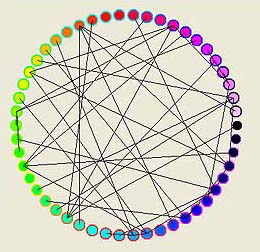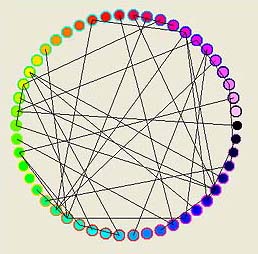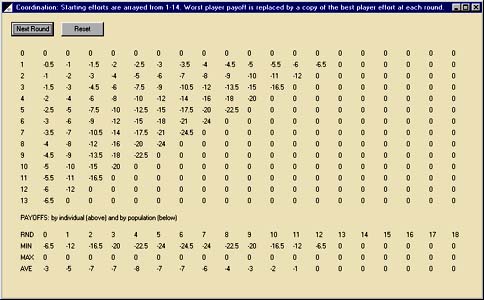|
Networks
- C++ Builder 6 Applications
|
|
|
Networks 4
A slight modification of the previous version. More
node options are available to set all captions to tags numbers, make all
captions visible or not visible, and level all nodes to minimal strength.
Link options have been reorgainzed so that they may be given varying strengths,
the links reduced to minimal strengths, or the links destroyed alltogether.
|
|
|
Networks 3
This version allows you to associate labels with the
shapes and agents.
Captions in labels should contain NO blank spaces. Configurations should
be saved and opened as *.txt files so that they may be edited in NotePad.
These files are NOT fully compatible with those of previous versions.
|
|
|
Social (and other) Networks 2
An enhancement to the foundation that allows:
- Opening and saving
network configurations.
- Adding links of
various strengths by right-click drag-and-drop.
- Editing the strengths
of agents visualized by their size.
- Moving agents
by left-click drag-and-drop.
|
|
Social (and other) Networks
A foundation for creating and visualizing various
configurations of networks. They could be conceptual, geographic or social.
Both random and hierarchical networks may be created, and the configurations
untangled by dragging-and-dropping the array of TShape objects on the
screen.
To do: Add automatic
untangling and analysis. Add directionality and traffic volume to the
links. Add different layers of links representing kinship, friendship,
business and terrorist affiliations. Add visualizations and analytical
tools to ananlyze the complex coincidence of different networks among
agents.
|
|
|
|
|
|
|
|
| |
|
|
Kinship - (Artificial Culture
8)
A world in which marriages and births are mediated
by kinship systems. The population will grow to as many as 400 personoids,
each of whom knows its kinship relationships to all 400 others. In all,
as many as 160,000 relationships are remembered and tracked. This application
contains code for five distinct Windows (Units 1 - 5). It makes use of
the Zeigler components.
|
|
|
Forager - (Artificial Culture
7)
An ongoing simulation project... The graphic presents
a birds-eye-view of agents foraging for food on a landscape where resources
are distributed in various different patterns. The viability of the agents
(their ability to expoit the food that is present) is a complex function
of their search strategy and other factors.
|
|
|
Planet Wator - A 5-State Cellular
Automaton Implementation
Can Wator be simulated
by a multistate cellular automaton? This is an incomplete attempt to answer
that question. Try manipulating the rules without making use of gestation
and stomach size (they have not been fully implemented).
Inspired by alife.fusebox.com Planet
Wator simulation.
|
|
|
Dave's New-and-Improved Wator
A simulation of a simulation.
Sharks feed on smaller fish in this virtual ecosystem.
Inspired by alife.fusebox.com Planet
Wator simulation.
|
|
|
Planet Wator - A Cellular Automata
Implementation
A simulation of a simulation.
Sharks feed on smaller fish in this virtual ecosystem. Each cell has three
states: shark, minnow and empty ocean. Each cell state is a function of
its neighboring cells. Gestation and stomach size have not been implemented.
Inspired by alife.fusebox.com Planet
Wator simulation.
|
|
|
Graph Types and a Second Window
An illustration of using Canvas metods to draw graphs
on the main Window, a second Window, a PaintBox component and an Image
component.
|
|
|
Run, Step, Stop and Canvas Methods
Canvas graphics are ephemeral, meaning that they can
be erased with a Refresh() call (the "Clear" button) or obliterated
when another Window obscures them momentarily. The green/magenta figure
is drawn when "Draw" is pressed. The blue/cyan figure is drawn
when "FormPaint" is fired. The small figures are drawn by pressing
the run/step/stop/initialize buttons. The order in which functions are
declared, described and called is illustrated.
|
|
|
Dave's Color Chase
Cells are filled with
a random selection of colors with the three sliders. Dark colors are disallowed
because of poor visibility. Colors tend to migrate towards like colors.
This is a variation on the class of segragation problems.
|
|
|
Coordination Game
This coordination game
begins with 14 players each willing to put an effort of from 1 to 14 (respectively)
into a group activity. The rules of the activity are these: At each round
each player will receive a payoff equal to the minimum effort exerted
by all the other players minus half the effort invested by that player.
player[i].payoff = min(player[0-13].effort)
- .5*(player[i].effort;
The game ends after 14 rounds with
all players exerting zero effort.
|


